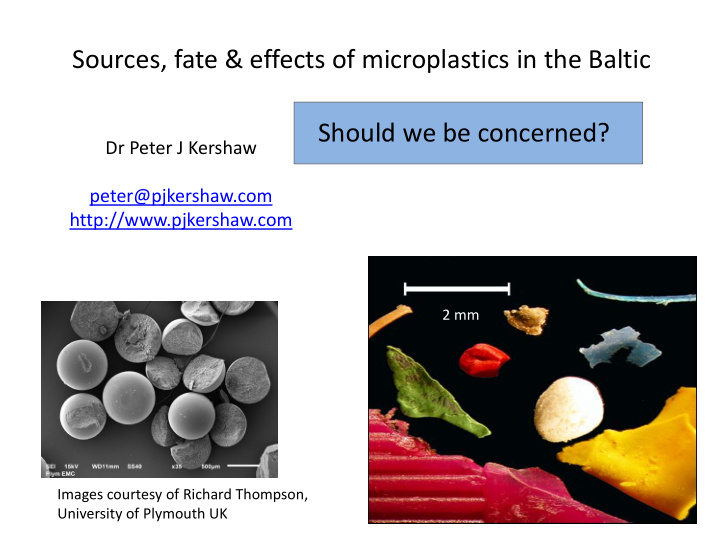



Sources, fate & effects of microplastics in the Baltic Should we be concerned? Dr Peter J Kershaw peter@pjkershaw.com http://www.pjkershaw.com 2 mm Images courtesy of Richard Thompson, University of Plymouth UK
Example: What are expanded microplastics? polystyrene < 5mm No agreed ‘official’ definition < 100 nm nano-particles (Graphic from GESAMP 2015, inspired by Won Joon Shim, KIOST)
Examples of ‘primary’ microplastics – made for a purpose Plastic resin pellets – used by Toothpaste extract plastics industry Facial scrub extract a) images courtesy of: a) Joel Baker; b) Hideshige Takada; c) A. Bakir & R. Thompson) (GESAMP in press)
Examples of ‘primary’ microplastics – made for a purpose Plastic resin pellets – used by Toothpaste extract plastics industry Improved protocols to reduce spillage Facial scrub extract a) images courtesy of: a) Joel Baker; b) Hideshige Takada; c) A. Bakir & R. Thompson) (GESAMP in press)
Prevention is the key The Swedish Chemicals Agency (SCA) proposes that: 1. the Government prohibit the sale on the Swedish market of rinse off cosmetic products that contain plastic microbeads. (Apply from 1th of January 2018). 2. Sweden continue to seek to achieve an EU-wide regulation. If and when this is in place, a Swedish ban should be adapted to the EU- wide one. Proposal is legal under EU law (REACH, Cosmetics regulations) Complement any voluntary agreements Produce a ‘level playing field’ HELCOM ML Stakeholder Conference 3/9/2016 5 Johanna Eriksson
‘Secondary’ microplastics: wear/weathering/fragmentation of larger plastic objects Examples: Large-scale shellfish Fragmentation of macro-debris by UV aquaculture, South Korea Fibres from clothing Wear & tear of fishing gear Dust from car tyres Damage to aquaculture structures Paint flakes EPS debris, S Korea, OSEAN NOAA Marine Debris Program More complex waste management issue
Land-based sources of microplastics Improved collection & treatment of wastewater & solid waste
Sea-based sources of microplastics Improved design & modified practices (ship loading, fishing gear design ………)
How bad is the Baltic? Modelling the relative abundance of floating microplastics Sources estimated using three proxies: Coastal population density Shipping density Proportion of urbanised catchment (more rapid run-off) -93,000 (taken from the Transboundary Waters Assessment Programme, http://geftwap.org )
Modelling the distribution of different types of plastic micro-particles (330 microns), introduced by rivers Seawater average Polyethylene (PE) Polystyrene (PS) Polyethylene terephthalate (PET) density = 1.025 Density = 0.91 Density = 1.05 Density = 1.40 Surface waters (model layer 1) PE floats PS intermediate PET sinks Bottom waters (model layer 12) (Van der Meulen et al. 2015,EU MICRO project)
Secondary microplastics - fragmentation rate poorly quantified - varies with environmental compartment (GESAMP 2015)
Impacts: Ingestion by birds, fish, invertebrates ……… Stomach contents of an individual northern fulmar ( F.glacialis ) from Svalbard in the Arctic. (images courtesy of Jan van Franeker and Alice Trevail) Scale bar indicates 10 mm (Trevail et al. 2015)
Impacts: Microplastics as a source of contaminants? Plastics absorb and desorb contaminants – e.g. PCBs, DDT & other POPs Some plastics release chemical additives – e.g. PBDEs PBDEs (polybrominated diphenyl ethers) - used as a flame retardant on textiles & as an additive in some plastic products, and are endocrine disrupters Gut transfer of PBDE flame retardants from plastic to fatty tissue Short-tailed shearwaters, northern North Pacific Ocean Kosuke Tanaka, Tokyo Univ. Agric. & Technol. Tanaka et al., 2013, Mar. Poll. Bull ., 69, 219-222
Microplastics & seafood safety Actual risk Perceived risk – consumer choice Microplastics found in a wide variety of fish and shellfish ‘…….. the uptake of plastic-associated chemicals in humans due to inadvertent ingestion of microplastics in seafood appears likely to be no more significant than other human exposure pathways of these chemicals. However significant knowledge gaps and uncertainties remain, particularly for nano-sized material, and this may justify a more precautionary approach .’ UNEP (in press)
Rafting – potential social& economic impacts? Microplastics as linked to jellyfish outbreaks (image courtesy of Erik Zettler/SEA) Medusa of the giant jellyfish Nemophiliema nomurae Planulae favour plastic over natural substrates: Yellow Sea, Sea of Japan planula polyps Microbial biofilm on microplastic from North Atlantic: includes pathogenic Vibrio bacteria (images courtesy of Shin-ichi Uye, Univ. Hiroshima)
Microplastics - key message: we should be concerned Many different sources and entry points (therefore multiple intervention points and measures needed) Distributed widely in the ocean (dependent on composition) Widespread uptake by biota Absorption and release of harmful chemicals Present in seafood Potential for consumer concern Potential for rafting of organisms Cannot be removed from the ocean – prevention is the key
Recommend
More recommend